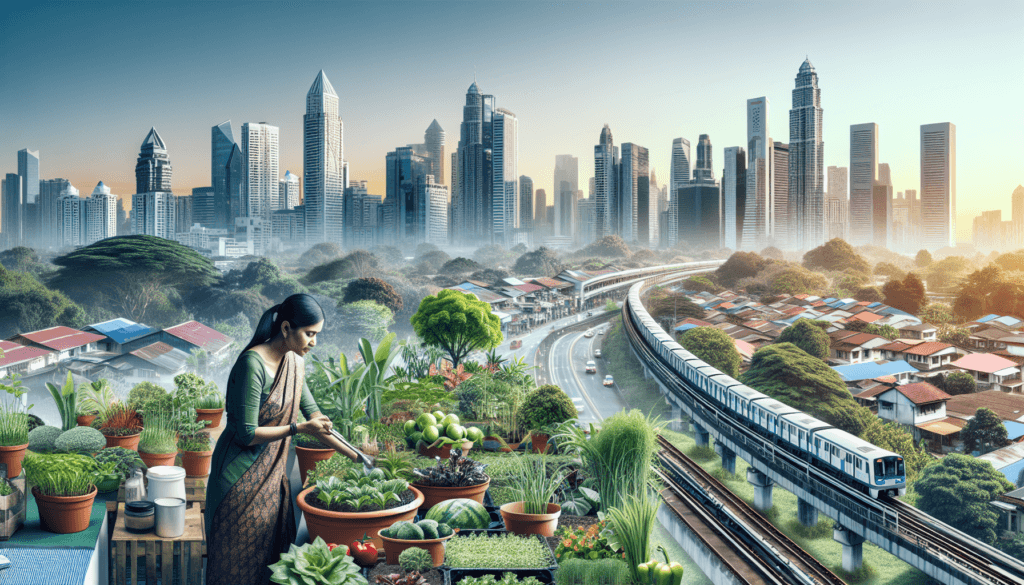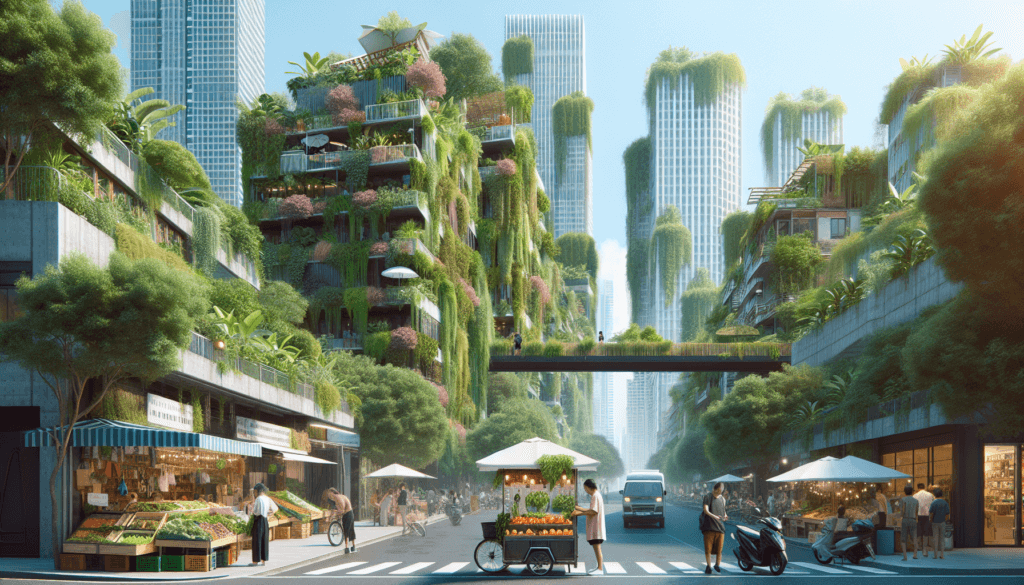Urban agriculture plays a significant role in ensuring food security in cities. As the world’s population continues to grow, the demand for food is increasing at an unprecedented rate, especially in urban areas. With limited agricultural land available in cities, urban agriculture provides a practical solution to this challenge. It involves cultivating crops, raising animals, and producing food within urban environments. By utilizing rooftops, empty lots, and community gardens, urban agriculture not only increases access to fresh and nutritious food but also promotes sustainable food production practices. This article explores the vital role that urban agriculture plays in ensuring food security for urban populations and highlights its numerous benefits for both individuals and communities.

1. Importance of Food Security
Food security is a pressing issue faced by societies around the world. It refers to the availability, accessibility, and affordability of sufficient and nutritious food for all individuals. Achieving food security is crucial for promoting the well-being and development of communities. Without adequate access to food, individuals and communities may suffer from malnutrition, hunger, and various health issues. Urban agriculture plays a significant role in addressing food security challenges by providing localized food production, improving access to fresh produce, and reducing food deserts.
2. Definition and Overview of Urban Agriculture
Urban agriculture can be defined as the practice of cultivating, processing, and distributing food within or around urban areas. It encompasses a range of activities, from large-scale commercial operations to small community gardens. Urban agriculture has gained traction in recent years as urban populations increase and the demand for locally grown and sustainable food rises.
2.1 Origins of Urban Agriculture
Urban agriculture has its roots in ancient civilizations, where food was grown within city limits to ensure a stable food supply. In modern times, the concept of urban agriculture gained prominence with the rise of industrialization and the diminishing availability of arable land in urban areas.
2.2 Types of Urban Agriculture
There are several types of urban agriculture practices that vary in scale and scope. Rooftop gardens, community gardens, vertical farming, and urban aquaponics are some examples of urban agriculture initiatives. Each type has its unique characteristics, advantages, and challenges.

3. The Link Between Urban Agriculture and Food Security
Urban agriculture is closely linked to food security through various mechanisms.
3.1 Localized Food Production
One of the key benefits of urban agriculture is its ability to produce food locally. By cultivating crops and raising livestock within or near urban areas, urban agriculture reduces the reliance on long-distance transportation and global supply chains. This localized food production contributes to food security by ensuring a more consistent and reliable supply of fresh, nutritious food.
3.2 Improved Access to Fresh Produce
Urban agriculture also enhances access to fresh produce, especially in underserved communities known as food deserts. Food deserts are areas characterized by limited access to affordable and healthy food options. By establishing urban agriculture initiatives in these areas, residents have increased access to fresh fruits, vegetables, and other agricultural products. This helps improve the nutritional quality of their diets and reduces the risk of diet-related health issues.
3.3 Reduction of Food Deserts
Urban agriculture contributes to the reduction of food deserts by bringing food production closer to the communities that need it the most. Rather than relying solely on supermarkets or grocery stores, urban agriculture initiatives provide local food sources that are more affordable and accessible. This helps address the inequalities in food access and ensures that residents have a reliable supply of nutritious food.
4. Benefits of Urban Agriculture for Food Security
The importance of urban agriculture in ensuring food security extends beyond localized food production and improved access to fresh produce. There are numerous benefits that urban agriculture provides in promoting food security.
4.1 Climate Change Resilience
Urban agriculture can contribute to climate change resilience by integrating sustainable practices. For example, rooftop gardens and vertical farming utilize unused urban spaces, reducing the need for additional land clearance. These practices also reduce the carbon footprint associated with long-distance transportation of food. By implementing sustainable farming techniques, such as organic farming or water-efficient irrigation systems, urban agriculture can help mitigate the impacts of climate change on food production.
4.2 Economic Empowerment
Urban agriculture initiatives can have a positive impact on local economies and promote economic empowerment. By creating jobs and entrepreneurial opportunities, urban agriculture fosters economic growth in urban areas. Additionally, the production and sale of local agricultural products contribute to the circulation of money within local communities. This economic empowerment can have ripple effects, improving the overall well-being of individuals and contributing to food security.
4.3 Health Benefits
Urban agriculture promotes healthier lifestyles and improves public health. By increasing access to fresh produce, urban agriculture encourages individuals to consume a more balanced and nutritious diet. This reduces the prevalence of diet-related diseases, such as obesity, diabetes, and cardiovascular diseases. Furthermore, the physical activity involved in urban agriculture activities, such as gardening or farming, contributes to improved physical and mental well-being.

5. Challenges and Limitations of Urban Agriculture
While urban agriculture offers numerous benefits for food security, it also faces several challenges and limitations.
5.1 Land Availability and Cost
One of the primary challenges of urban agriculture is the limited availability and high costs of land in urban areas. Urban lands are often in high demand for other purposes, such as housing or commercial development. This makes it challenging for urban agriculture initiatives to secure suitable land for cultivation. The cost of land in urban areas is also significantly higher compared to rural areas, posing financial barriers for aspiring urban farmers.
5.2 Limited Scale of Production
Another limitation of urban agriculture is its limited scale of production. Due to space constraints in urban areas, agricultural activities are often restricted to small plots of land or containers. This limited space reduces the quantity of food that can be produced, limiting its overall impact on food security. Scaling up urban agriculture initiatives requires innovative solutions and creative use of available spaces.
5.3 Knowledge and Skill Gap
Successful urban agriculture requires knowledge and skills in various areas, such as farming techniques, pest management, and marketing. However, many individuals interested in urban agriculture lack the necessary knowledge and training to establish and maintain productive urban farms. Bridging the knowledge and skill gap through educational programs and training opportunities is crucial to the success and sustainability of urban agriculture initiatives.
6. Successful Initiatives and Case Studies
Despite the challenges, there have been numerous successful urban agriculture initiatives that have made a significant impact on food security.
6.1 Rooftop Gardens in Cities
Rooftop gardens have gained popularity in many cities worldwide. These gardens utilize unused rooftop spaces to grow a variety of crops, including vegetables, herbs, and even small fruit trees. Rooftop gardens not only provide fresh produce but also help insulate buildings, reduce energy consumption, and mitigate the urban heat island effect. Examples of successful rooftop gardens can be found in cities like New York, Chicago, and Singapore.
6.2 Community Gardens
Community gardens are another impactful form of urban agriculture. These gardens are typically managed and maintained by local residents who share the responsibilities of cultivation and harvesting. Community gardens foster a sense of community and provide individuals with the opportunity to grow their own food in shared spaces. Successful community garden projects can be seen in cities like Seattle, Portland, and Vancouver.
6.3 Vertical Farming
Vertical farming is an innovative approach to urban agriculture that maximizes production in limited spaces. This method involves growing plants in vertically stacked layers or in tall structures, utilizing technologies such as hydroponics or aeroponics. Vertical farming has the potential to significantly increase food production in urban areas while minimizing resource use. Examples of successful vertical farming projects can be found in cities like Tokyo, New York, and London.

7. Policy Recommendations to Support Urban Agriculture
To fully harness the potential of urban agriculture for food security, supportive policies and regulations are necessary. The following policy recommendations can help create an enabling environment for urban agriculture initiatives:
7.1 Zoning and Land Use Policies
Local governments can implement zoning regulations that specifically designate areas for urban agriculture. By identifying suitable land for cultivation and protecting it from other development pressures, urban agriculture can have a more secure future. Additionally, land use policies can prioritize agricultural activities in urban planning and ensure long-term access to land for urban farmers.
7.2 Financial Incentives
Financial incentives, such as tax breaks or grants, can encourage individuals and organizations to invest in urban agriculture. These incentives can offset the high costs associated with land, equipment, and infrastructure necessary for urban farming. Financial support can also help small-scale farmers establish and expand their urban agriculture businesses.
7.3 Education and Training
Education and training programs are essential for supporting the success of urban agriculture initiatives. Local governments and organizations can provide workshops, courses, and resources that equip individuals with the necessary knowledge and skills for urban farming. These programs can cover various aspects, such as farming techniques, business management, and marketing strategies, enabling urban farmers to thrive.
8. The Future of Urban Agriculture and Food Security
The future of urban agriculture looks promising as more communities and governments recognize its potential in addressing food security challenges. Advancements in technology, such as vertical farming systems and hydroponics, will continue to improve the efficiency and productivity of urban agriculture. Additionally, increased awareness of the environmental and health benefits of locally grown food will drive the demand for urban agriculture initiatives.

9. Conclusion
Urban agriculture plays a crucial role in ensuring food security by providing localized food production, improving access to fresh produce, and reducing food deserts. The benefits of urban agriculture for food security extend beyond these factors, encompassing climate change resilience, economic empowerment, and health benefits. Although urban agriculture faces challenges related to land availability, limited scale of production, and knowledge gaps, successful initiatives and case studies demonstrate its potential. By implementing supportive policies, providing financial incentives, and offering education and training opportunities, governments and communities can pave the way for a future where urban agriculture contributes significantly to food security.
10. References
- “The Role Of Urban Agriculture In Food Security.” Food Tank, 13 Apr. 2022, foodtank.com/news/2022/04/role-of-urban-agriculture-in-food-security.


